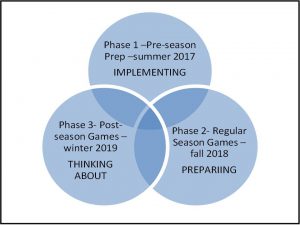by Peter A. Arthur-Smith, Leadership Solutions, Inc.®
“We have become one of the most bureaucratic, confusing, litigious societies on the planet…We have to get our act together” Jamie Dimon, CEO, JP Morgan Chase Bank, Wall Street Journal Business article, July 2017.
 |
Although CEO Dimon was referring to the US society as a whole, could his views also mirror the state of our individual businesses, institutions or associations? He clearly felt it applied to government of all stripes. Judging from the way the management discipline has shaped the mechanisms of our organizational life, our answer to the opening question has to be “Yes.” Management is primarily about policies, procedures and systems, in its quest to automate, delineate and regulate everything we do within our immediate enterprise. Has it therefore unwittingly hoodwinked us into a boondoggle in our desire for success?
One way to find out is to switch into some leadership modes to gauge the difference we experience in organization momentum. If we suddenly find that our enterprise jolts into life and progress without having to crack the whip as much, or drive our people as
much, or that gaining ground is not so much of a slog anymore; just maybe we’ll have found a better alternative. Then we’ll know we’ve been caught-up in the management cycle for way too long. So how does one make the shift?
To be realistic, it’s virtually impossible to go from a crawl to 100 mph in one-fell-swoop. More realistically you make progress in meaningful but challenging phases, rather than unrealistically expecting to hit high gear before you can even run. It’s suggested, therefore, that you consider breaking-out in at least three phases:
»Initial Priority Phase
»Priority Streaming Phase
»Strategic Priority Phase (Framing rather than Planning)
»Initial Priority Phase (First Gear) – A key advantage of starting with a Priority Session is its potential to kick-off in a TEAM mode. Consequently, if you have the opportunity to combine this session with an exercise that promotes team thinking, you should do so. (NOTE: Consider using LSI’s Communication Preference Survey [CPS], since it will enhance team connection possibilities.)
Once you have participants thinking more like a team, you can then initially break them into groupings of 3-6 players to contemplate your organization’s priorities over the next 6-12 months. Give these break-out groups 20-30 minutes to clarify their thoughts on what they believe are your enterprise’s three most important priorities, right now.
After due time, bring those groupings back together and quietly challenge them to reach an across-the-board consensus on the most important priorities relative to their aggregated listing. Those top priorities will equate to the number of people-pairs that are present: e.g. 6 people =3 pairs, 10 people =5 pairs, 15 people = 6 pairs and one threesome. (NOTE: If you have the advantage of LSI’s CPS – mentioned earlier – then aim to pair people according their differing primary communication colors rather than have the same ones. This enables them to draw upon each other’s strengths; where pairing is the most effective way of getting something accomplished.)
Put the pairs (or threesome) to work over the next 30-60 minutes to contemplate – WHAT, HOW, WHO, WHEN & WHERE to go for allies – so that they produce specific action initiatives. These can subsequently be accomplished with your pairings co-opting an additional 2-4 people, drawn from across the enterprise, as a means of widening exposure and building more advocates within your organization for the desired outcomes.
Once complete, these should be shared with your other meeting teams; so as to increase commitment, gain valuable input, and aid encouragement. The implementation clock starts ticking from there. Don’t forget to celebrate their successes along the way, as a way of whetting the appetite of others to engage in future “pairing.”
»Priority Streaming Phase (Second Gear) – Once your key team is properly functioning in First Gear – probably after a 3-6 month stint working their way through their initial set of priorities – you can then introduce them to Priority Streaming.
As indicated with the adjacent pictogram, which is taken from an earlier article entitled – “How a Football Coach can win the Superbowl Next Year, again?” – you can envisage taking your team through the streaming cycle of Thinking, Preparing, and Implementing. However, experience shows us that it is better to start in reverse order, so that your team becomes comfortable with the flow. To that end:
 |
»Implementing Bubble – It equates pretty well to the earlier Initial Priority Phase your team will now be trained in. For this reason, participants should be more than ready to articulate and list the priority items that need to be focused on over the next 1-3 months. Again, split your team into pairs and assign them to their-your listed items for devising and implementing appropriate action initiatives.
»Preparing Bubble – Now they can list items to spend a certain amount of preparatory time on, even while implementing their prior listing. Again different pairs can take these preparatory items on, within appropriate time periods, even while they’re executing their earlier items. Pairings will be
decided by their natural interest, team orientation and expertise, and then take chosen items under their wings. People are capable of taking on more than one task, providing they time-sequence them appropriately. These items will then be ready for moving to their implementation phase.
»Thinking Bubble – Here your team will again list items – for eventual execution 3-9 months down the road, relative to their role; i.e. operational team 3 months: strategic team 9 months – that are important to think about prior to the Preparation or Implementation Phases. Again, you can pair people in different arrangements for doing this, relative to their interest, team orientation and expertise.
»Once all these phases are mapped out in your Priority Streaming chart, you can then orchestrate the ongoing cycle with them to create a continuous stream of implementation, preparation and thought activities. Now your enterprise will be in second gear.
» Strategic Priority Phase (Top gear) – Almost a year out you will be nicely moving along in second gear without having to push and shove everything. Your key team will be taking the same approach with their teams, hence will have more time to think strategically.
In order to move into top gear, you and your key people have to be as clear as possible about a four-sided framework: compelling Vision, key Know-how, vital Resources and inspiring Objectives-Human Outcomes. This means educating them in all four areas. Your author’s prior article, “2016 Plan Using Strategic Positioning and Frameworks” describes these quite explicitly. If need be, contact him at peter@ileadershipsolutions.com for a re-run.
Once their Strategic Framework – fundamentally different from a strategic plan, which is a management tool – is in place, your top team will have a really clear idea where it is going. Such clarity needs to be vibrantly comm-unicated at all levels within your organization, so that everyone else knows where the ship is going. When people know where they’re going, the following is likely to happen:
- They will start dreaming, anticipating and desiring the future that’s mapped out.
- They will start offering additional ideas on how the vision can be accomplished.
- Some will volunteer time to participate in extra enterprise-wide initiatives to help move the ball forward.
- Your people, across-the-board, will start cheering as milestones are accomplished.
- Many people will make themselves available for future initiative participation.
- And more?
Just imagine what your organization starts to feel and look like with all this intrinsic momentum and activity? The bureaucracy will rapidly start to fall away, the confusion will quickly disappear, and the litigious mindset will evaporate. What joy and relief will descend on your organization during every work-day. If enough of this happens within various organizations, it will begin to have an impact on society as a whole. Why not get started today?
To learn more about “the three levels of building momentum,” talk with:
